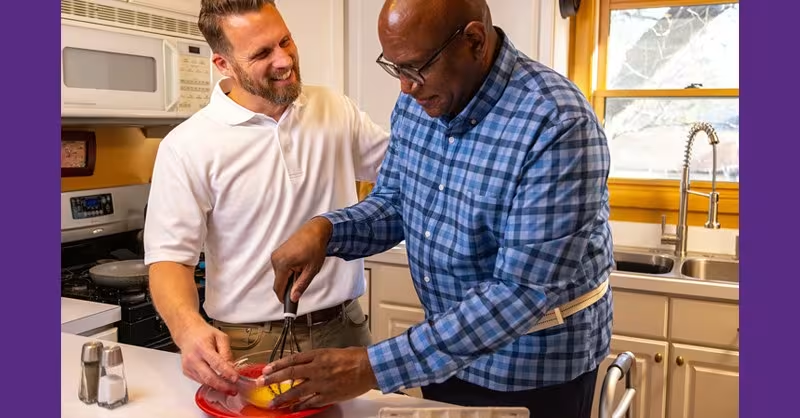4 Steps on How to Become an OTA with a Bachelor’s Degree
Each blog post is dated and contains accurate information as of that date. Certain information may have changed since the blog post’s publication date. If you would like to confirm the current accuracy of blog information, please visit our online OTA overview page or contact admissions at (877) 233-2677.
Are you wondering how to become an OTA with a bachelor’s degree? We explain the process in four steps, including how you can transfer previous college credits to cover some of the requirements for St. Kate’s Online OTA program.

A career as an occupational therapy assistant requires determination, commitment, and compassion — not to mention some solid skills and creative problem-solving. It’s no wonder why some people are surprised to learn that OTA is an associate degree. In fact, St. Catherine University’s Online OTA program prepares students to become capable OTAs in as few as 16 months.
Many of St. Kate’s OTA students are career changers who have already earned a bachelor’s degree. Becoming an occupational therapy assistant is a great decision, especially if you are looking for an incredibly rewarding and flexible career. If you already have a college education, and you are interested in occupational therapy, we’ve outlined how to become an OTA with a bachelor’s degree.
But first, let’s further explore what it means to be an OTA.
What Is an OTA?
An OTA is an occupational therapy assistant. These individuals work alongside occupational therapists (OTs) to help treat patients who may have a disability or are suffering an illness or injury. The main goal of an occupational therapy treatment plan is to increase the patient’s independence and quality of life. OTAs work in a variety of settings, including hospitals, schools, private practices and workplaces.
While the OT is responsible for evaluating and developing treatment plans for patients and overseeing them, the OTA puts those plans into action. OTAs teach individuals how to overcome the challenges of performing daily activities. One major difference between these two roles is that OTAs generally see more patients than OTs because OTs have additional paperwork that takes time to complete.

Curious about the difference between an OT and OTA? See how they compare and contrast and how the two professions work as a part of a team.
How to Become an OTA with a Bachelor’s Degree in 4 Steps
Now that you have some background information on what OTAs do, how exactly can you become one if you already have a bachelor’s degree? We’ve laid it out for you in four simple steps.
1. Meet All Admission Requirements
The first step to go from bachelor’s degree-holder to OTA is making sure you meet all the admission requirements for our OTA program. If you already have a college degree, you already meet our qualification for a high school diploma or a passing GED score. However, your GPA will also be considered. We require your college GPA to be at least a 2.5.
2. Complete Remaining Prerequisite Courses
Depending on your prior college experience, you may have some of the prerequisite courses for our program already under your belt. Be sure to speak with an admissions counselor about whether your coursework will transfer.

Our four OTA program prerequisite courses include:
- General anatomy and physiology with lab
- Medical terminology
- General psychology
- Lifespan development psychology
If you haven’t previously completed one or more of these classes, we offer them online through our university. This can be a great opportunity to get familiar with the formatting of our online courses, as this is how most of the material in our OTA program is delivered.
3. Successfully Complete St. Kate’s OTA Program
Did you know that St. Kate’s launched the nation’s first Associate of Applied Science (AAS) in OTA program in 1964? Since then, we’ve seen how the profession has grown and seen the increasing need for OTAs, so we pivoted to meet that need. With our students’ lives and schedules in mind, we became the first university to offer an AAS in OTA program that blends 80 percent online and 20 percent on-site curriculum.
By creating this hybrid program, we can ensure people like you can receive a quality education to become an OTA in the most efficient way possible — meaning they can help the people who need it sooner.

Our accredited online OTA program provides:
- A well-rounded science and liberal arts education
- A unique blend of online and on-site curriculum
- Personalized attention via small faculty-to-student ratios
- Diverse fieldwork opportunities that develop clinical and leadership skills
Over your 16 months in the program, you’ll also learn to work cooperatively with interdisciplinary teams under the supervision of an occupational therapist.

So what is OTA fieldwork? Fieldwork is where you’ll get critical hands-on experience in real-world settings.
As a student in St. Kate’s Online Occupational Therapy Assistant program, you’ll start by taking one to three semesters of liberal arts and sciences courses, which are available online, followed by the four-semester OTA professional course sequence. Phase 1 is where your bachelor’s degree comes in handy because you may be able to transfer some of your courses to meet general education requirements.
Our fast-tracked curriculum can be rigorous, but we offer resources to ensure our students receive the support needed to put their best foot forward when entering the profession. For example, we offer an NBCOT prep coaching program, career development assistance and other student resources. We also offer three start dates a year in January, May and September.
Our program is well-rounded and convenient and has a history of producing skilled OTAs. If you love to help people and want a fulfilling career in a growing sector of the healthcare industry, you owe it to yourself to get more information about St. Kate’s OTA program.
4. Pass the NBCOT Exam
Once you have successfully completed our OTA program, you must sit for the National Board for Certification in Occupational Therapy® (NBCOT) Exam to become a certified occupational therapy assistant. As mentioned previously, we offer an NBCOT prep coaching program, which we advise you take full advantage of.
Upon passing the exam and obtaining certification, you are ready to find work as an occupational therapy assistant. And based on the rapid growth of this profession, it won’t be too difficult for you to find a position. The U.S. Bureau of Labor Statistics projects 25 percent employment growth for occupational therapy assistants between 2021 and 2031.

See why it is worthwhile to become a certified occupational therapy assistant.
Learn More About How You Can Make a Difference as an OTA
Now that you know how to become an OTA with a bachelor’s degree, give us a call or fill out the form to learn more about how you can transform lives by becoming an occupational therapy assistant in as few as 16 months. When you do, we’ll provide you with a dedicated admissions counselor who will guide you through every step of the process.


